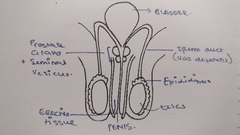![]()
![]()
![]()
Use LEFT and RIGHT arrow keys to navigate between flashcards;
Use UP and DOWN arrow keys to flip the card;
H to show hint;
A reads text to speech;
20 Cards in this Set
- Front
- Back
|
Sexual Reproduction |
Involves two parent organisms, which produce genetically different offspring. Fusion of a gamete from each of the male and female |
|
|
Where does sexual reproduction occur |
Eukaryotic organisms |
|
|
Plants (sexual reproduction) |
Pollen tube to ovary Pollen (male sex cell) produced by anthers Reach egg cells in the ovaries Become a seed Ovaries become a fruit |
|
|
Animals (External Eggs) |
Lots of eggs produced in the surroundings Less likely to survive |
|
|
Animals (Internal Egg) |
Needs to be a transfer, they have to be in close proximity and gametes not destroyed. Fewer eggs produced but more eggs produced and chances of survival increase because protection. Also have to look after young |
|
|
Sperm |
Semen protects them from the environment, inside the vagina and immune system destroys the sperm. More acidic in the vagina |
|
|
How is the sperm specialised |
Head packed with enzymes to digest its way through the egg membrane Strong tail for swimming |
|
|
What happens when the egg is fertilised |
Membrane structure changes so the enzyme in the sperm is no longer effective no other sperm can fertilise |
|
|
All forms of reproductions problem |
Water, need to be protected in a fluid |
|
|
How long do sperm survive for |
3 days |
|
|
Sperm Production |
Sperm develop optimum at less than 37° Testes are on the outside (so colder than the body temp) Increased Sperm Production Sperm go up the sperm duct from the testicles to the prostate gland and valve stops urination Secrete fluid to make semen, connected to the bladder |
|
|
Male Reproductive System Diagram |

|
|
|
Female Reproductive System |
Uterus in the womb where baby is being developed. Cervix separates uterus and vagina, dilates 10cm. Circular muscle, contracts and open and relaxed and closed. For birth |
|
|
HCG |
Stops menstruation In blood stream and filtered in the kidney |
|
|
How long does a egg last? |
A week |
|
|
Miscarriage |
If embryo is not implanted, menstruation occurs. Why miscarriage occurs: 1. Development failure, not enough blood or nutrition 2.something happens to women rejects development and some are more susceptible |
|
|
Inside the Womb |
Amniotic sac protects the baby. Placenta, maternal and fetal tissue is one organ. Allows diffusion of CO2 and Nutrition and the only way for diffusion is through the umbilical chord |
|
|
When Baby is Born |
Babys lungs fill with water and if it doesnt expel they collapse. Have to take a breath and expand for baby to live |
|
|
Placenta |
Allows mothers blood to come close to the babys, allows diffusion and exchange After an hour and 45 mins placenta comes out. If all the placenta didnt come out it becomes a medical emergency Some animals eat their placenta, for nutrition if they leave it, it will rot and smell attracting predators |
|
|
Female Reproductive System Diagram |

|

